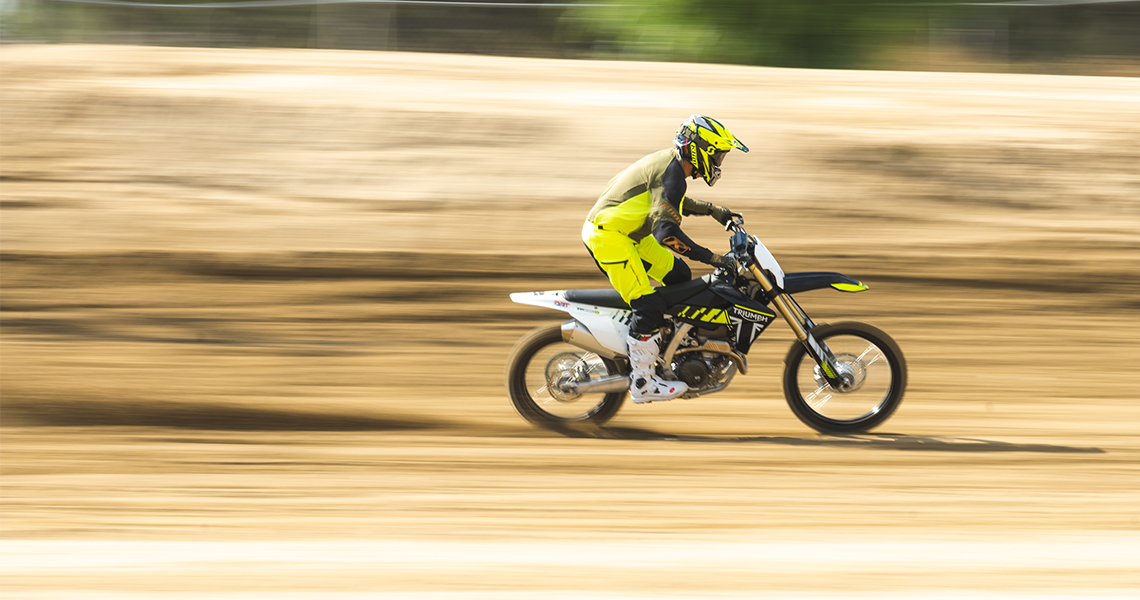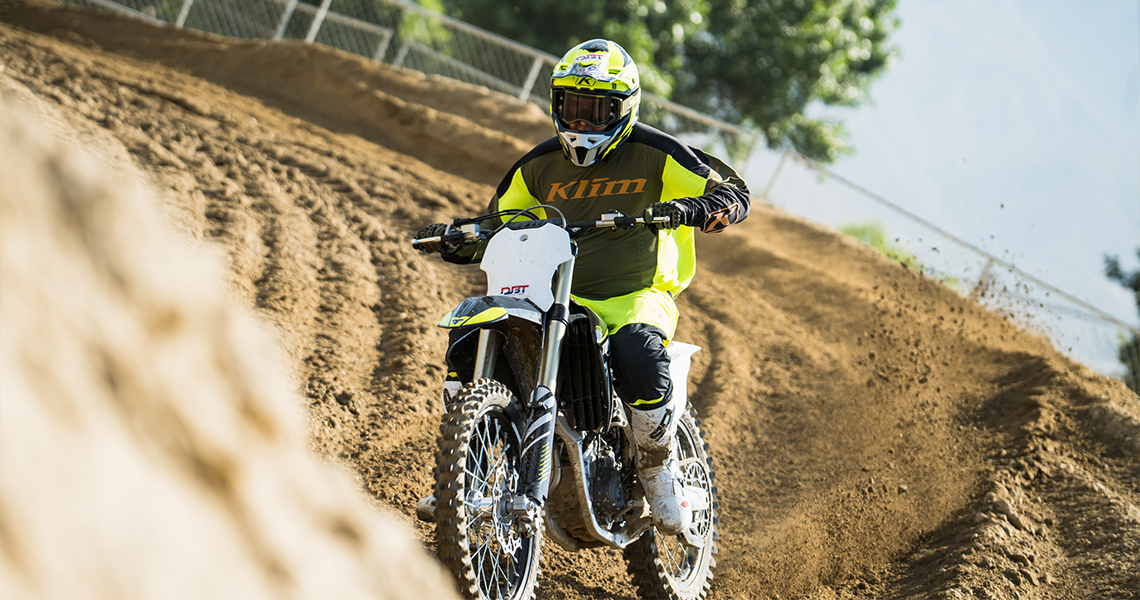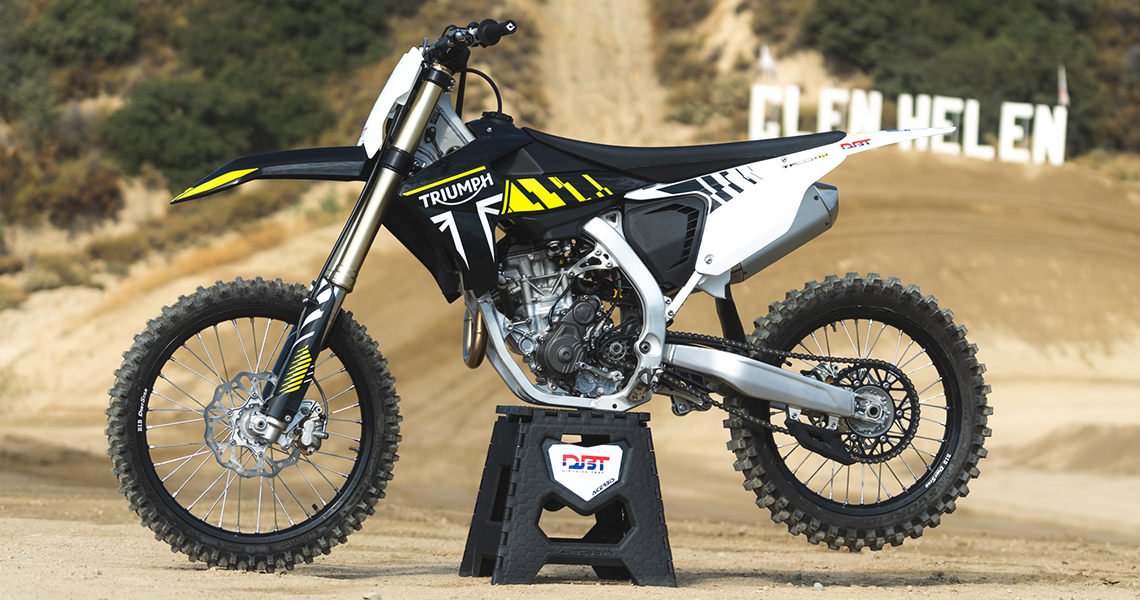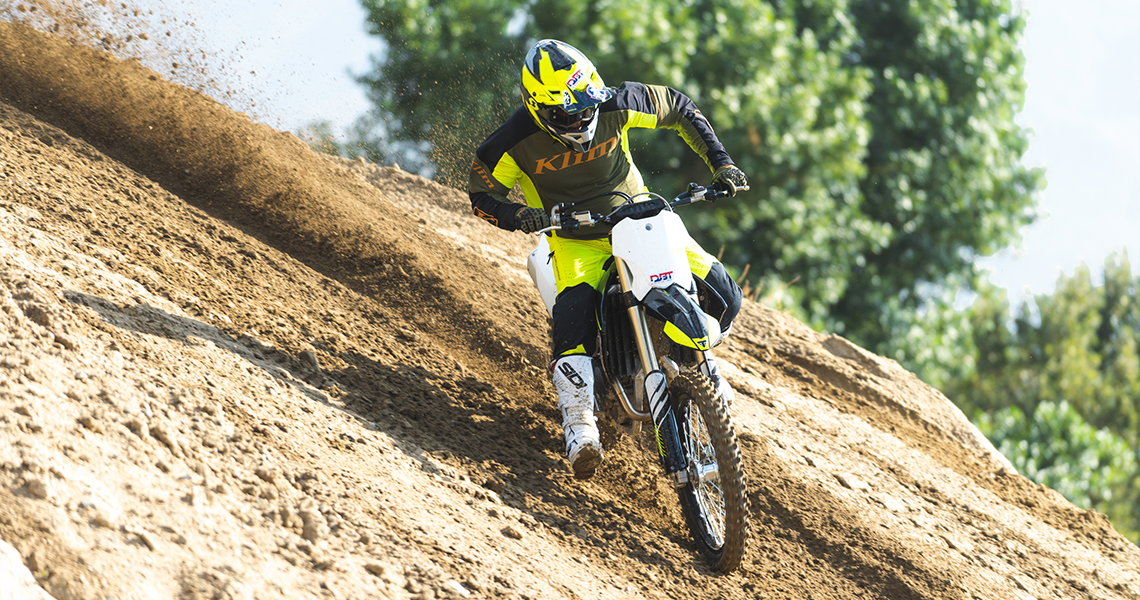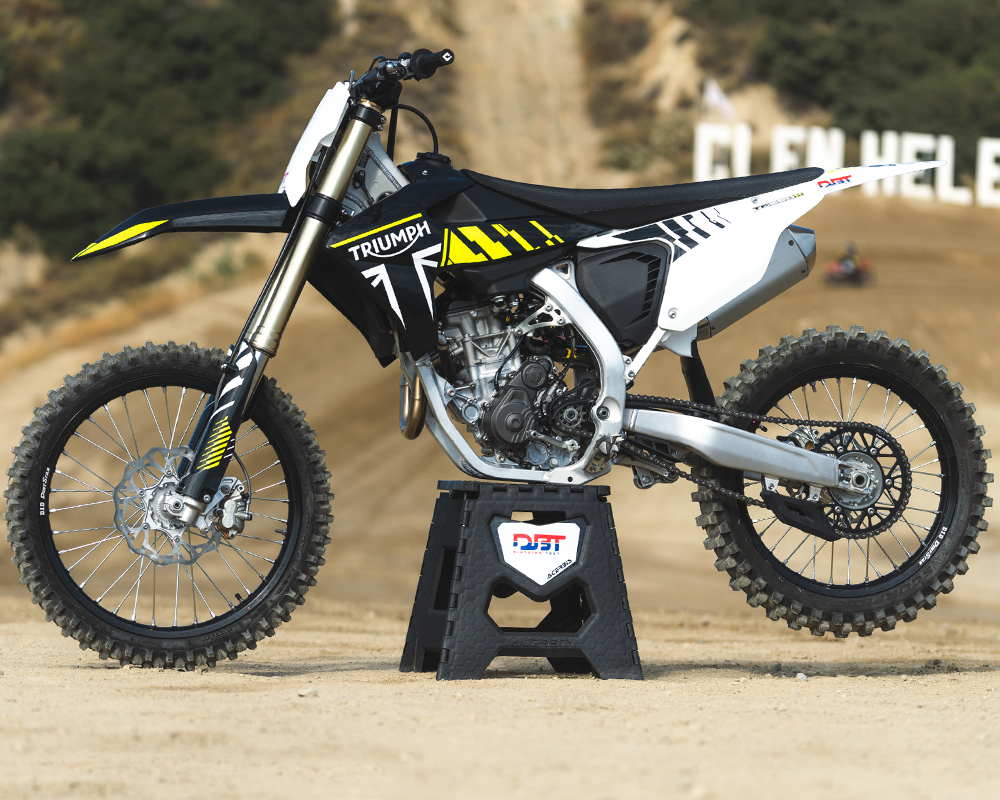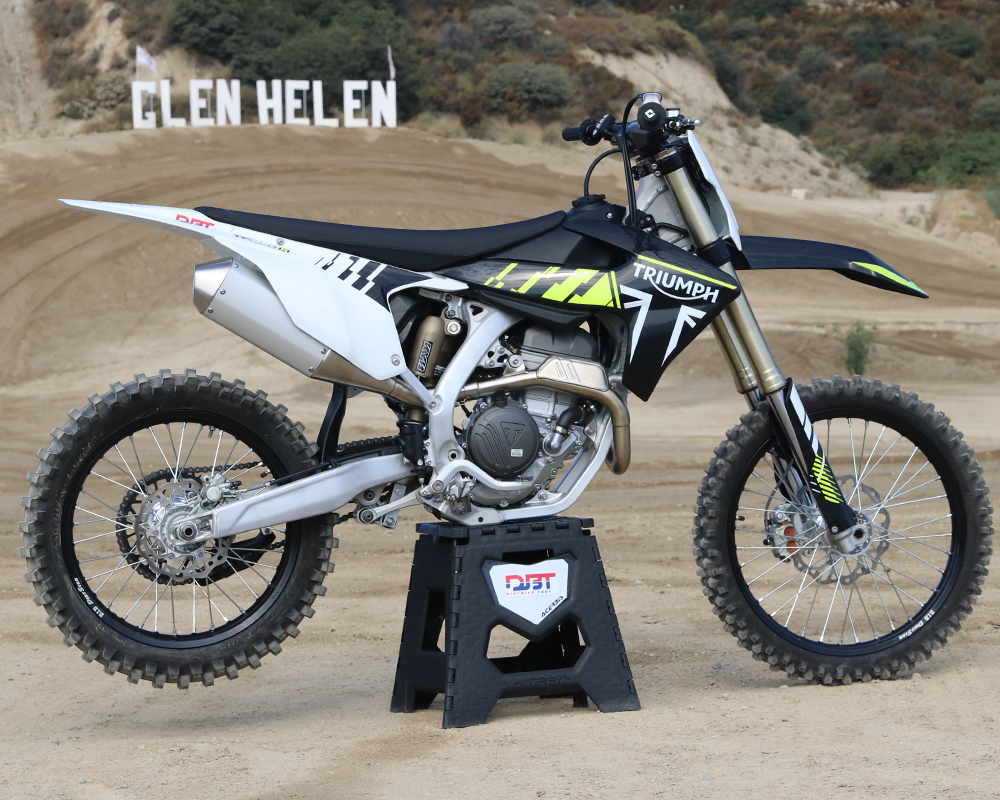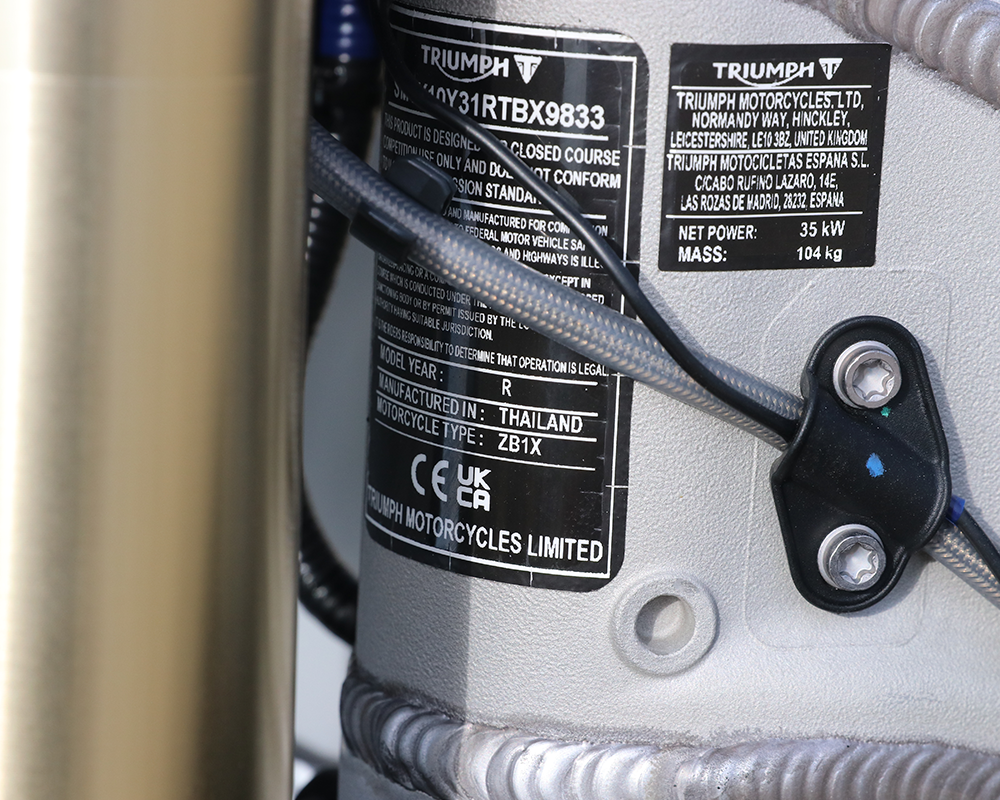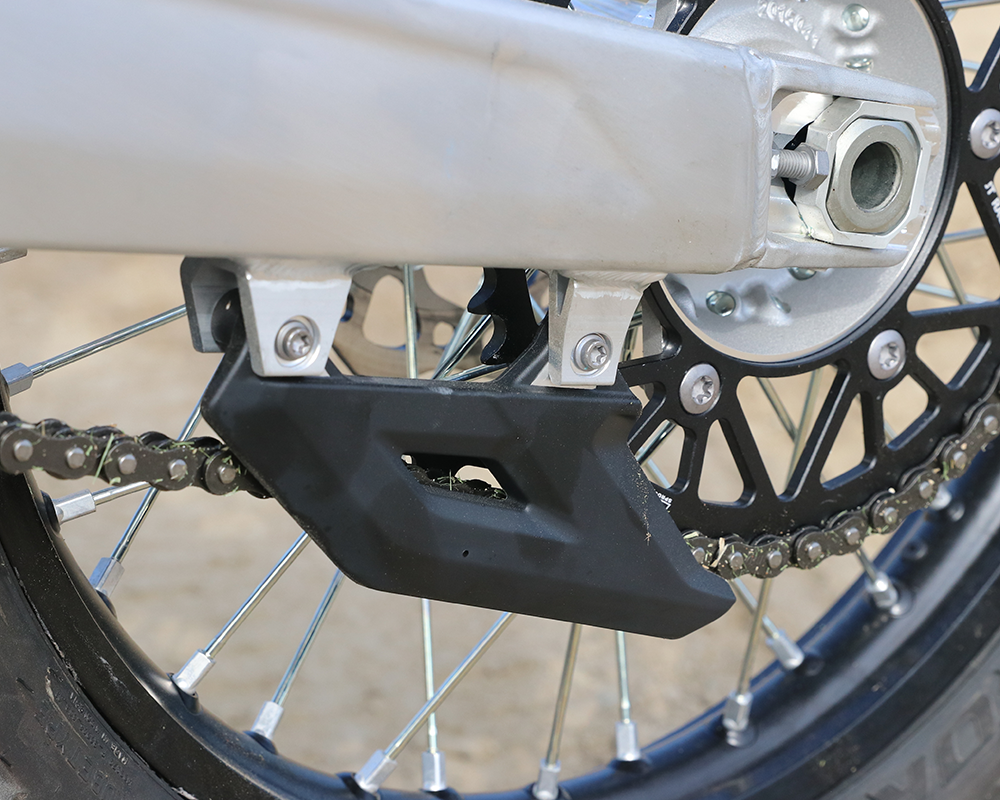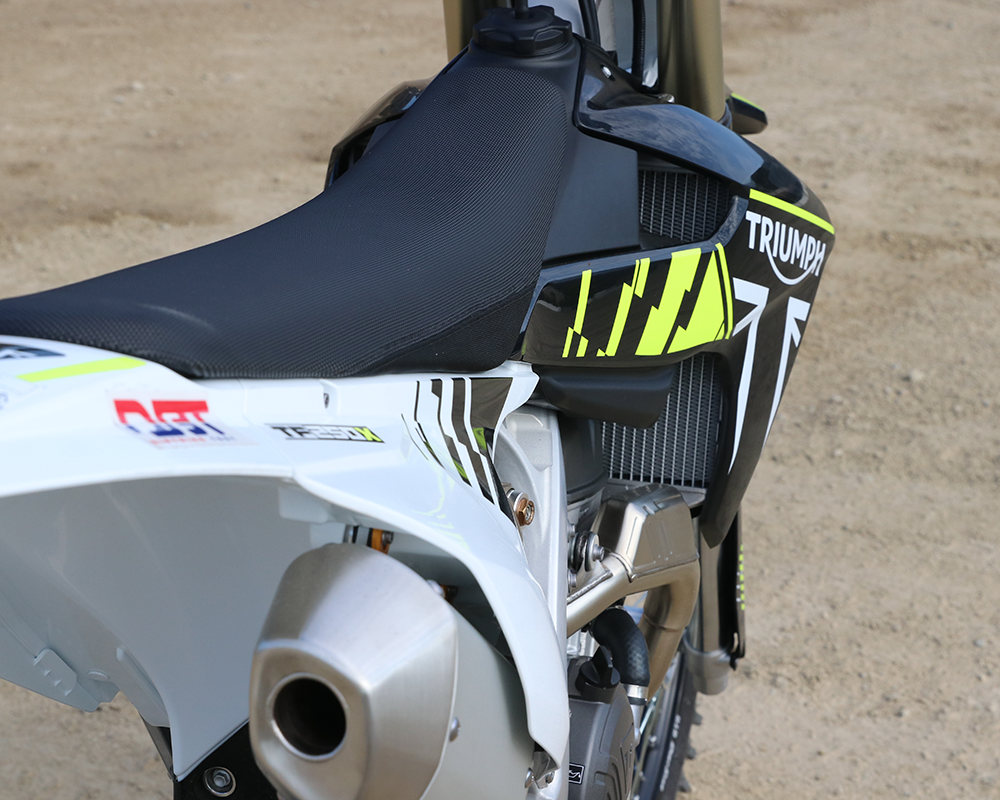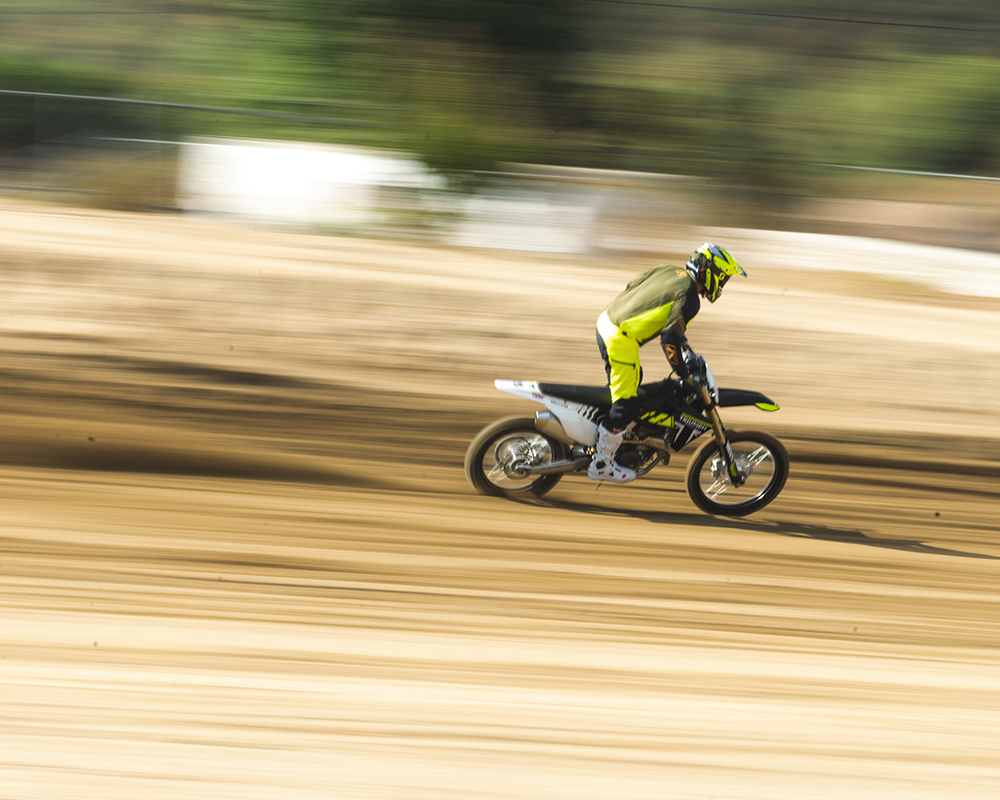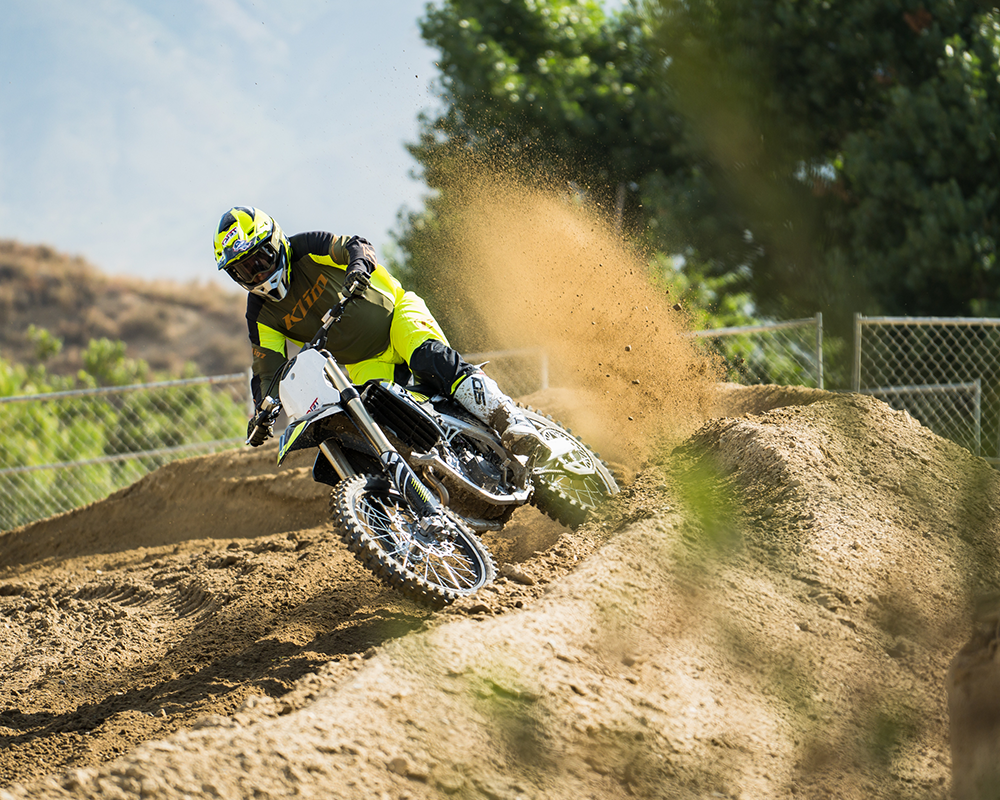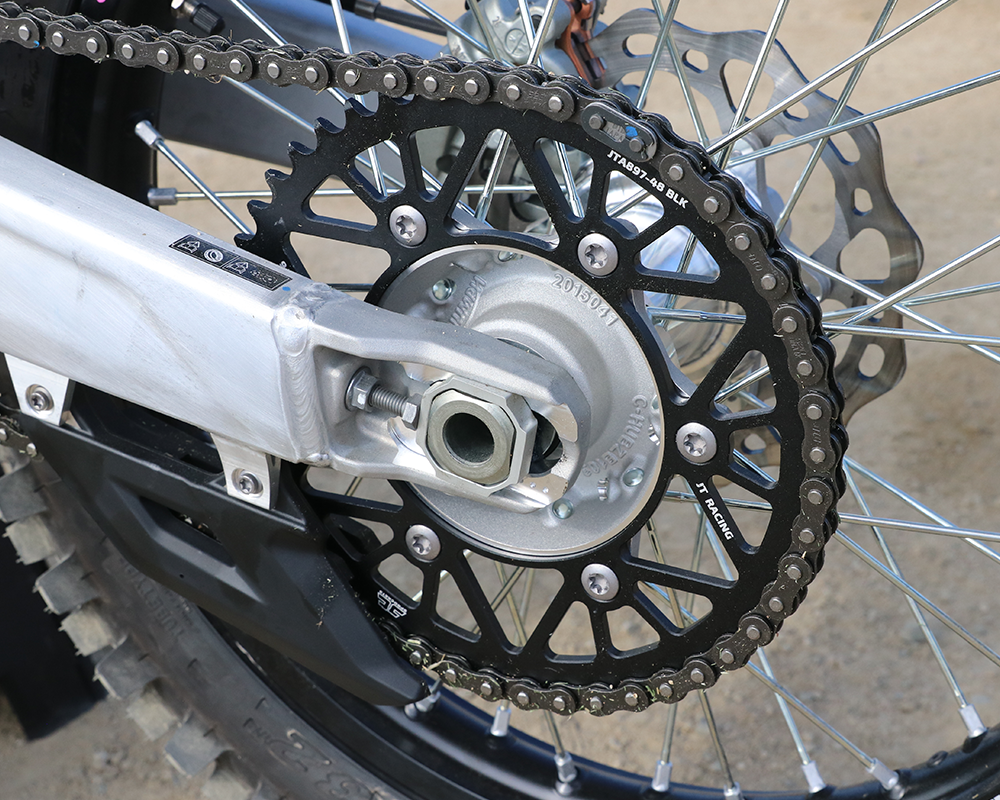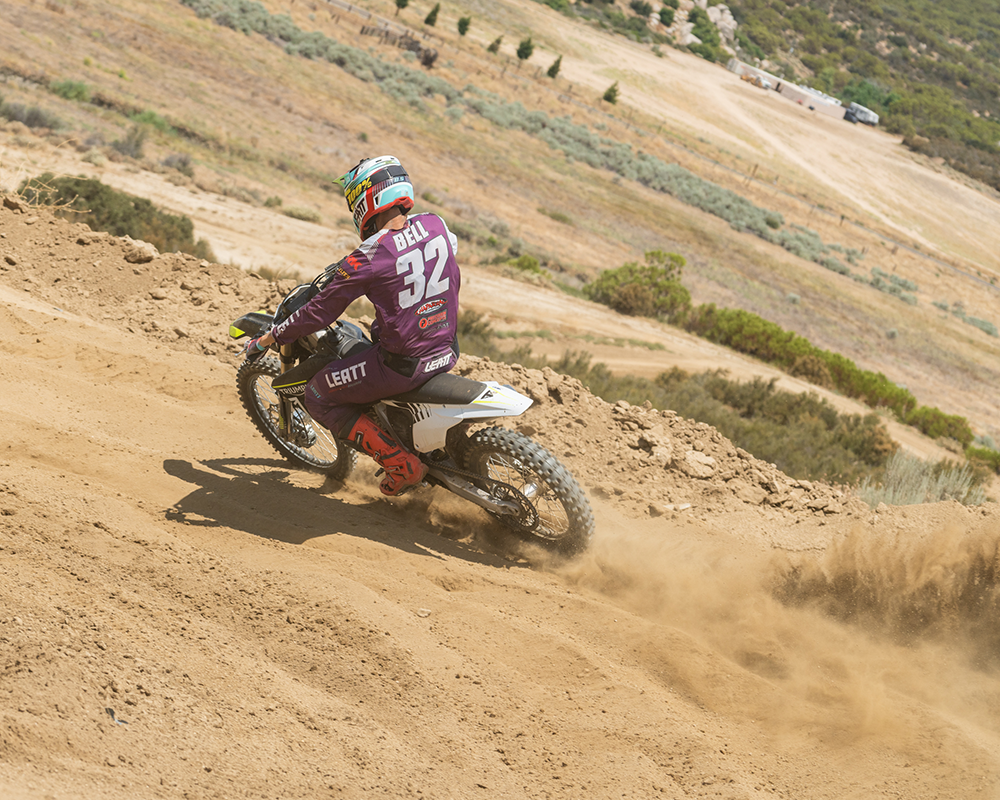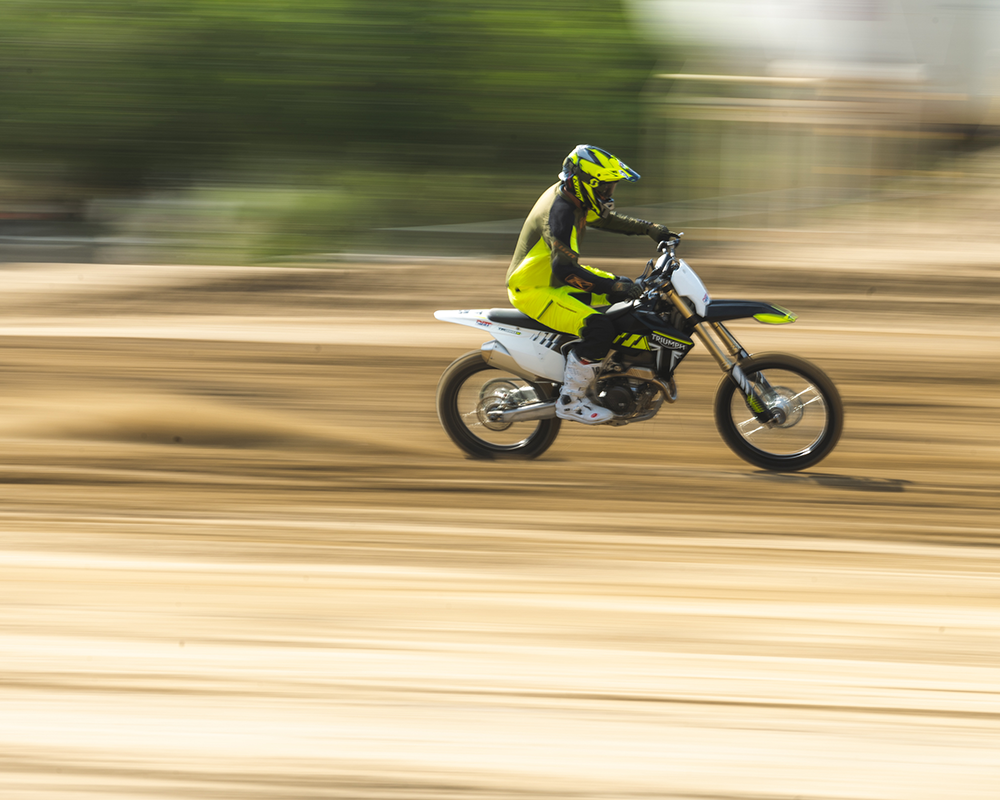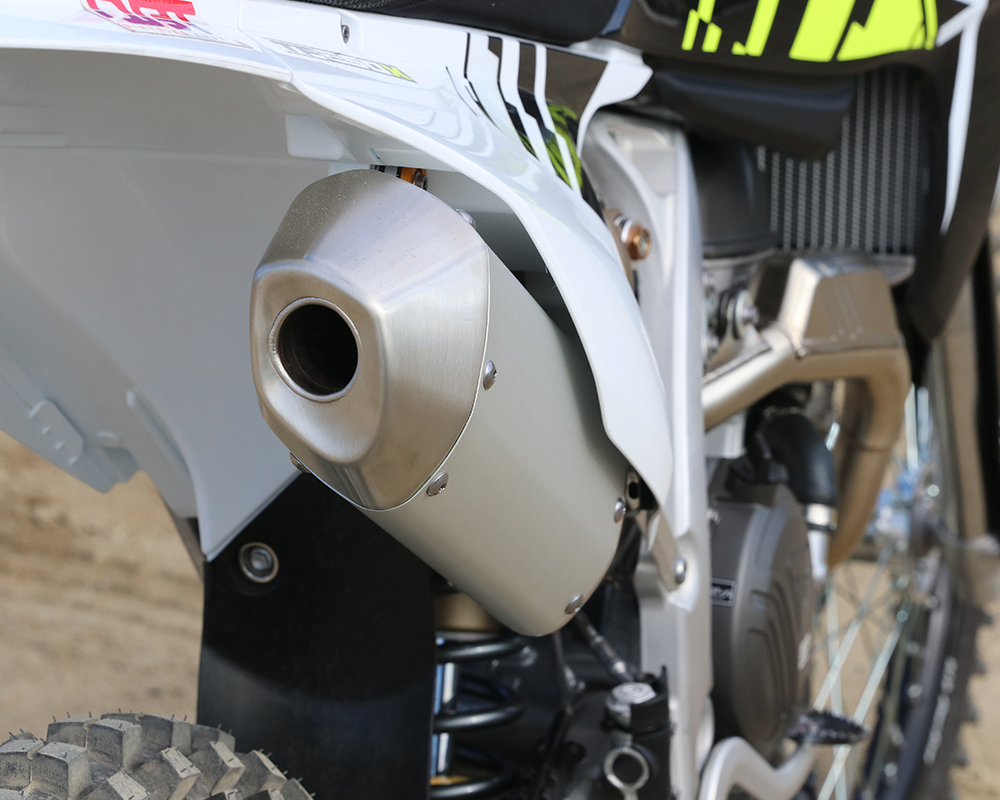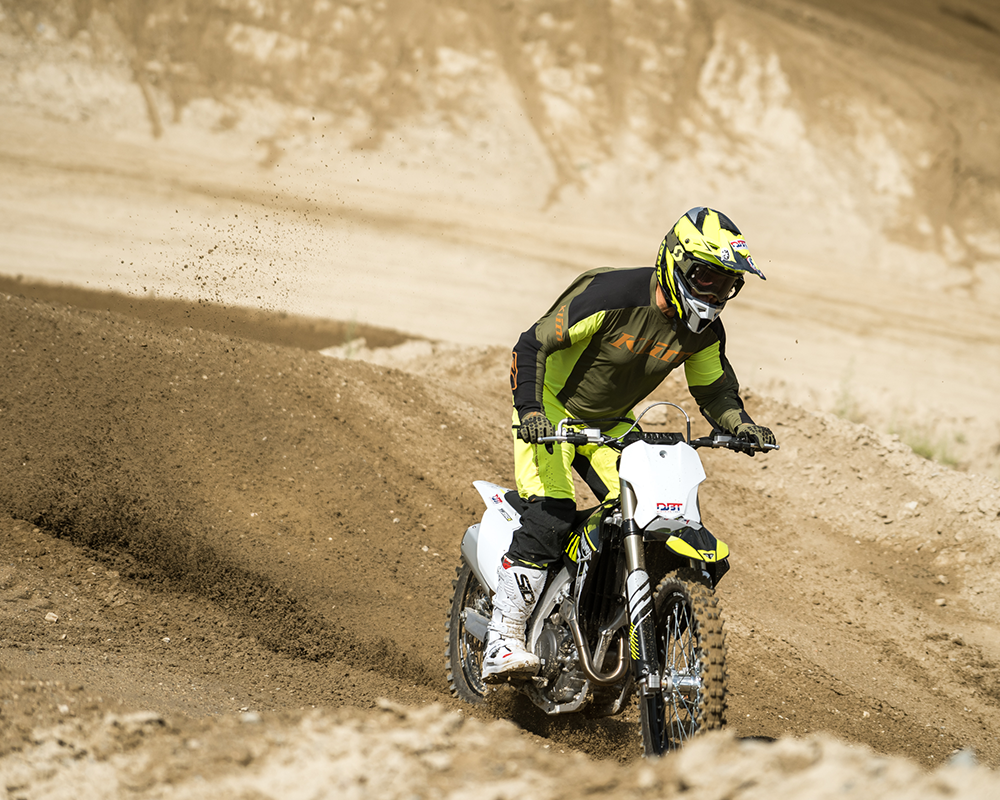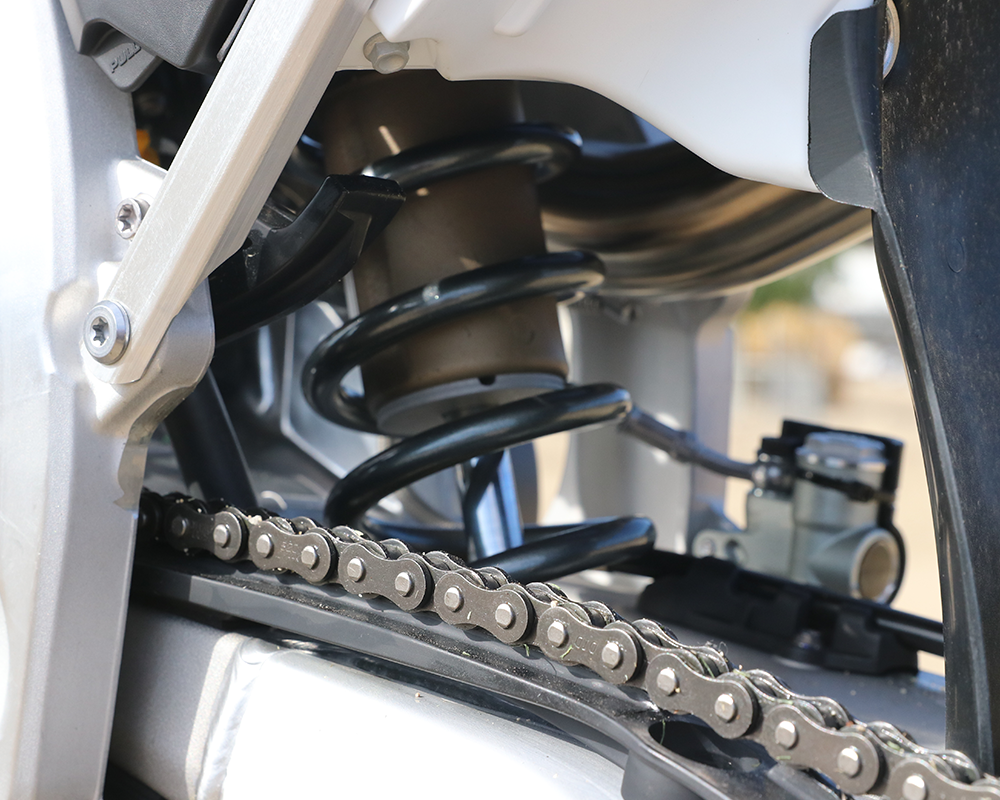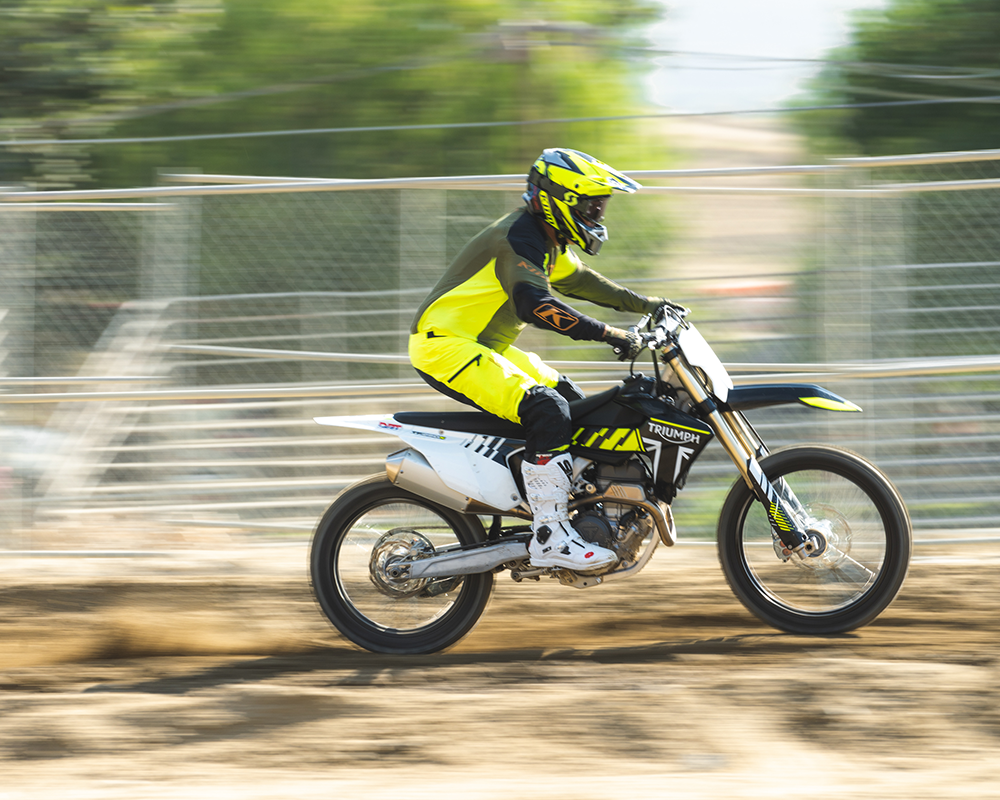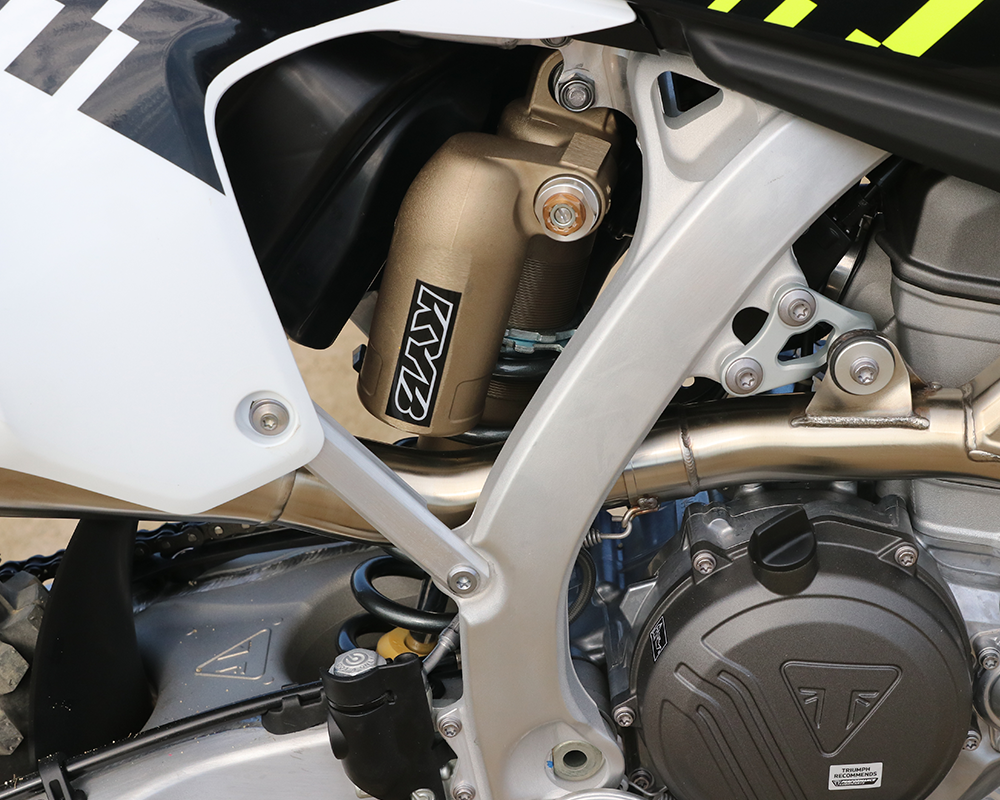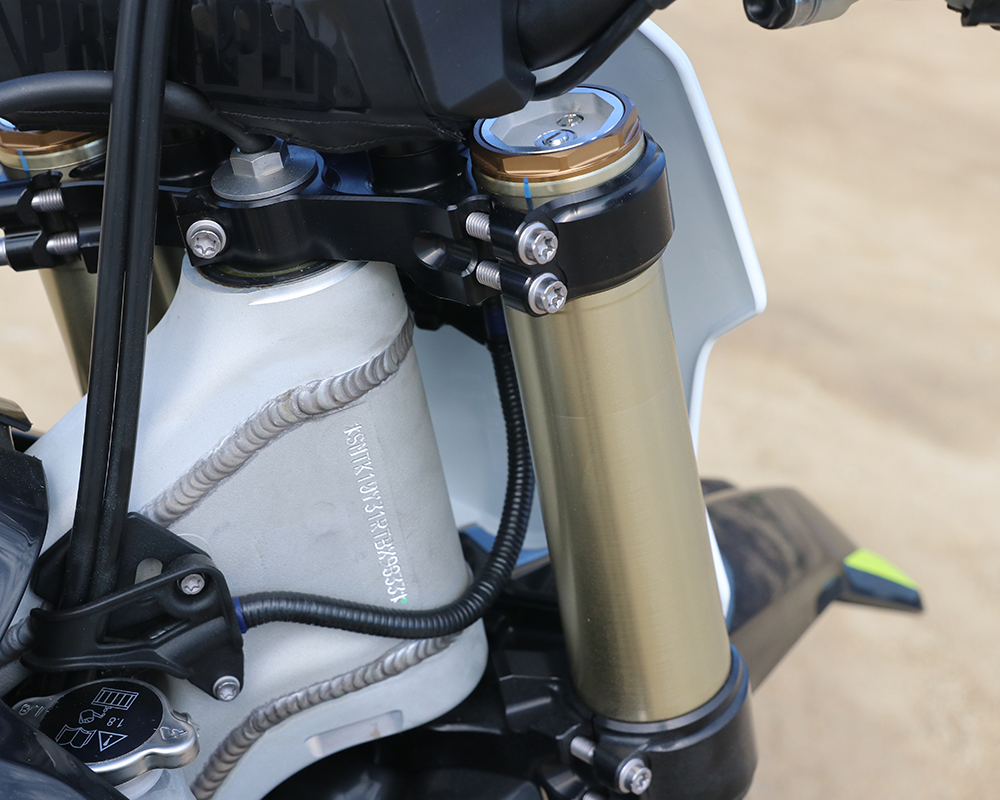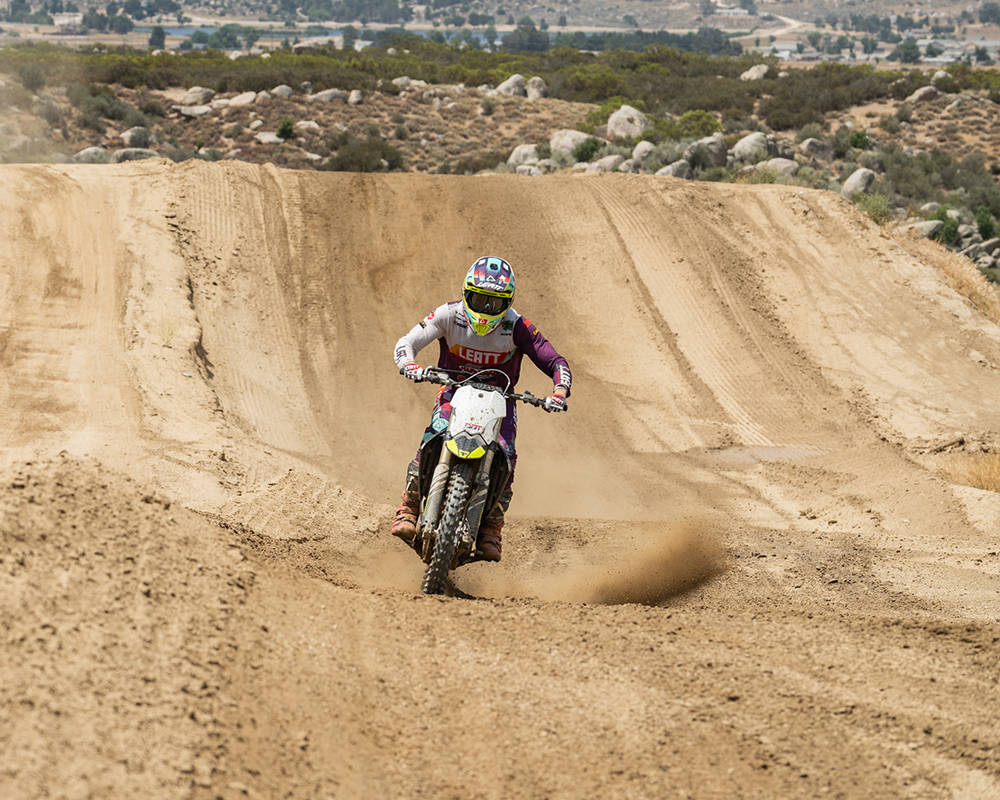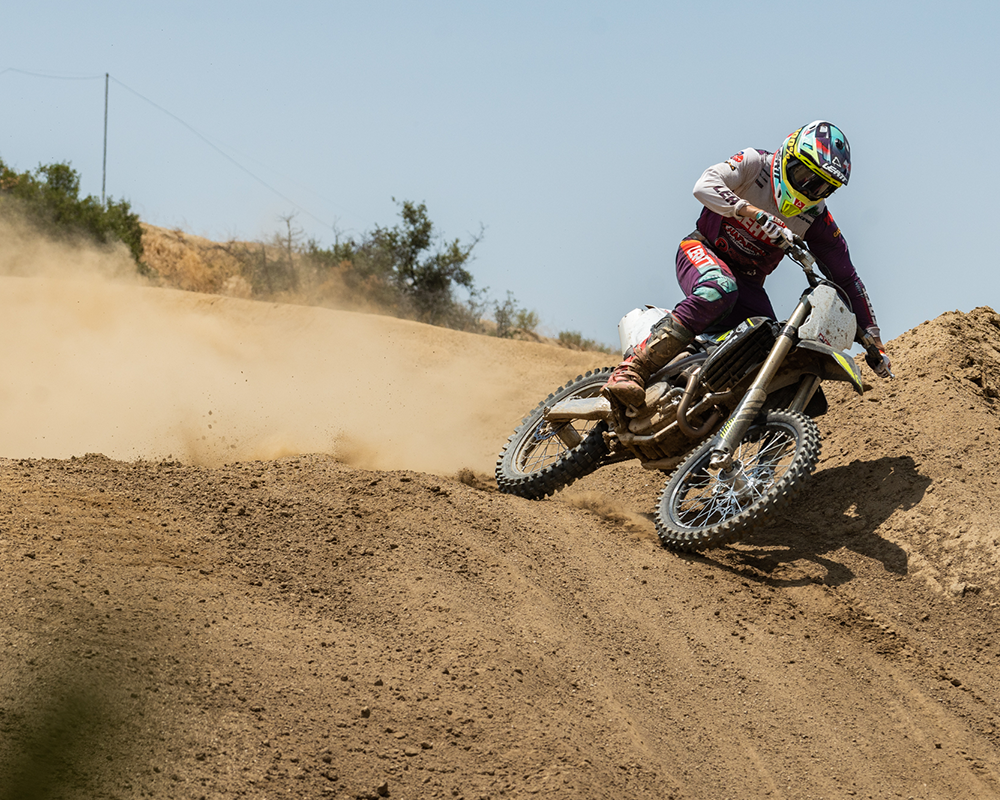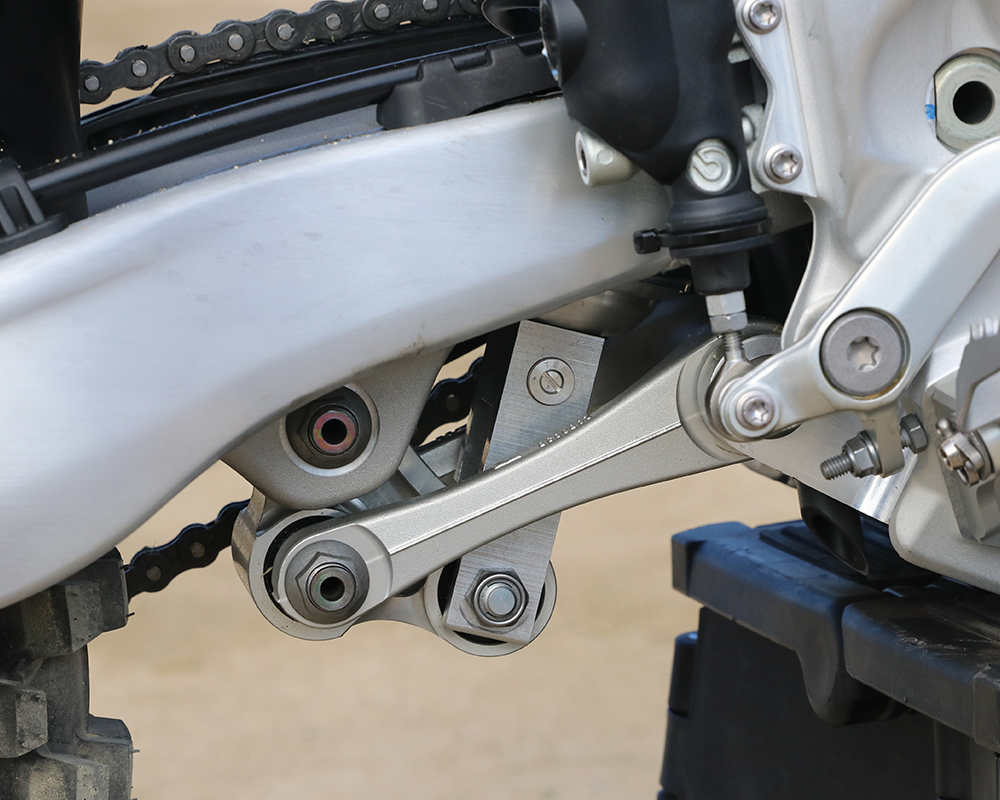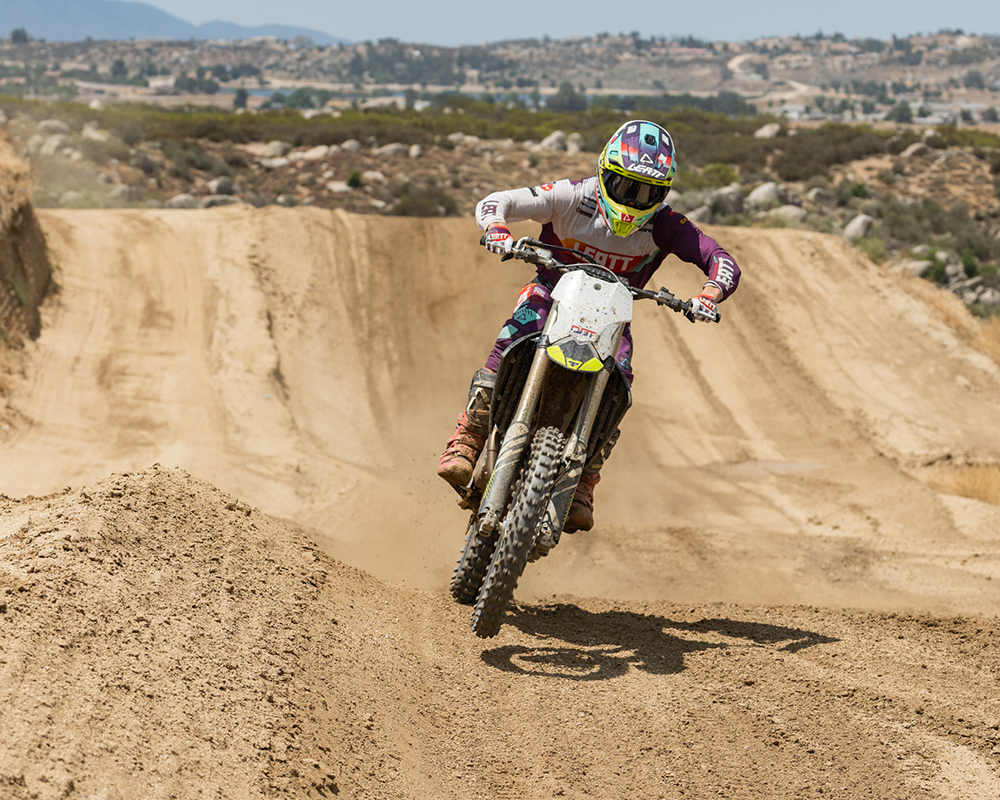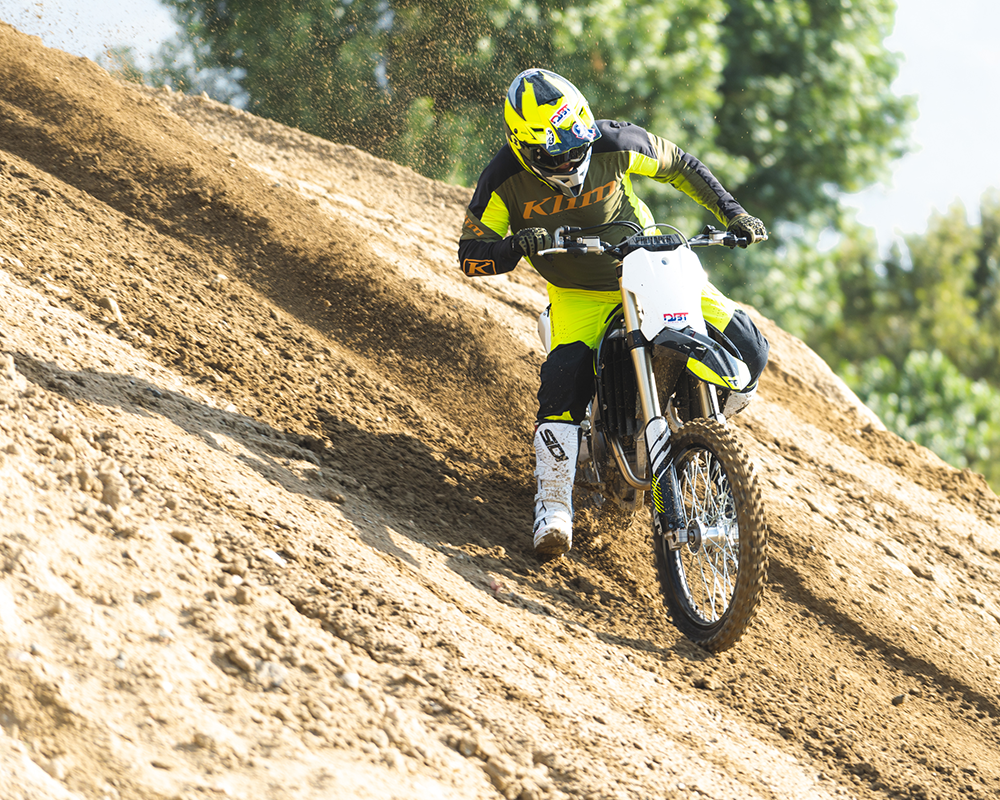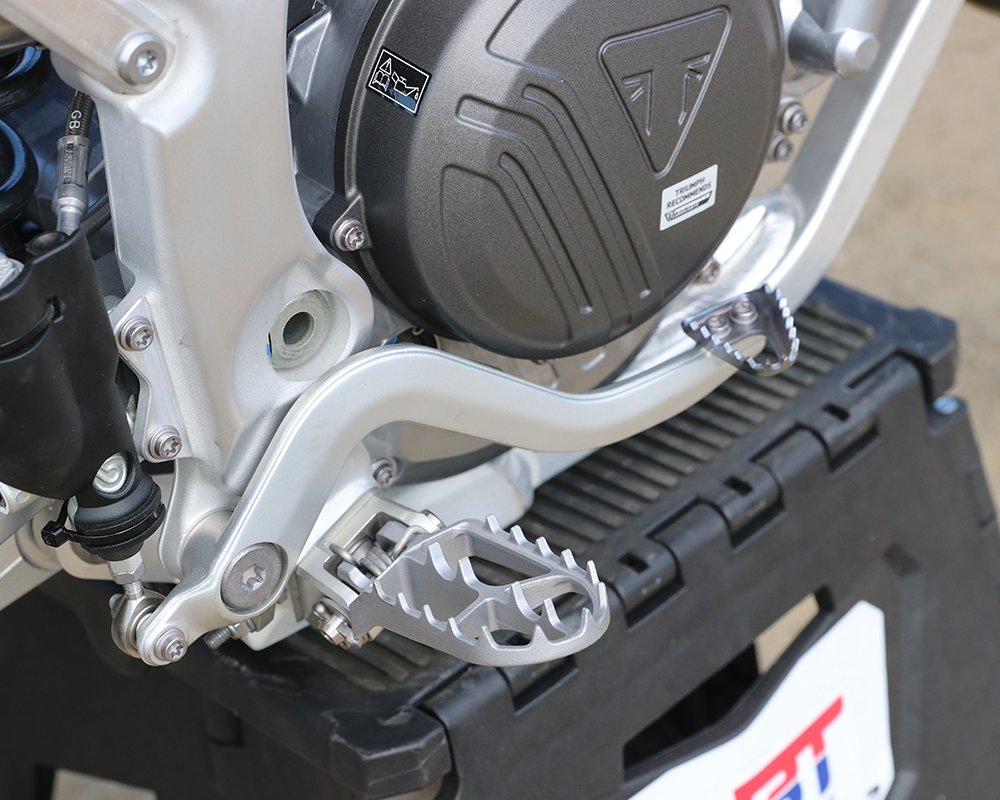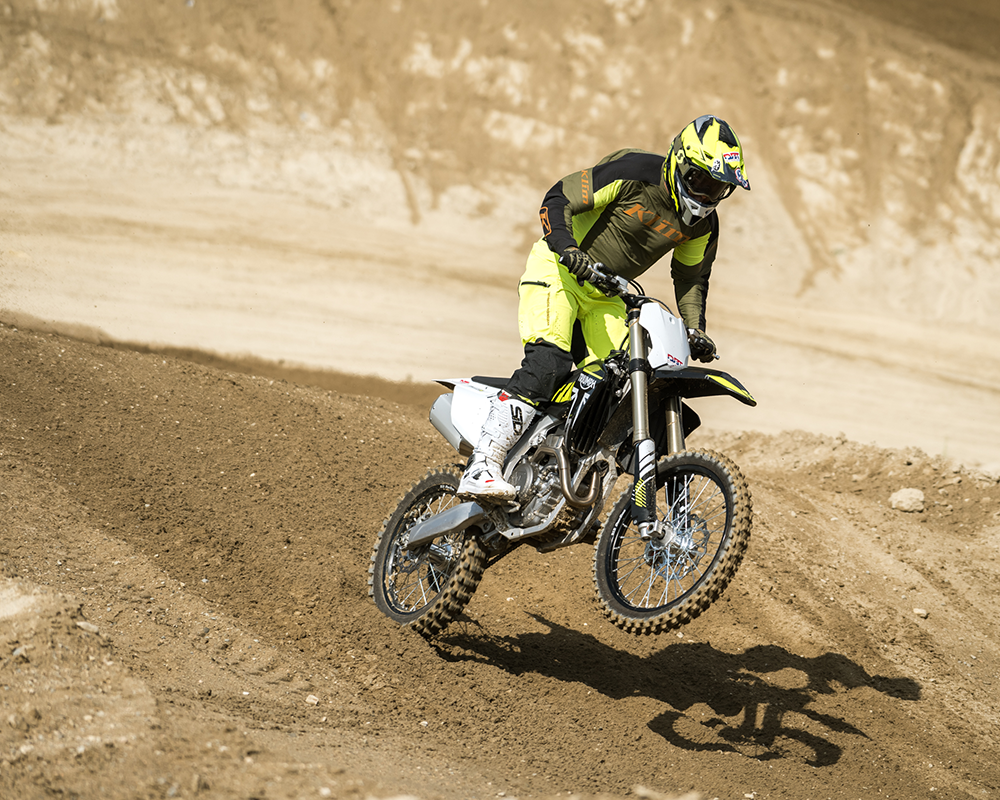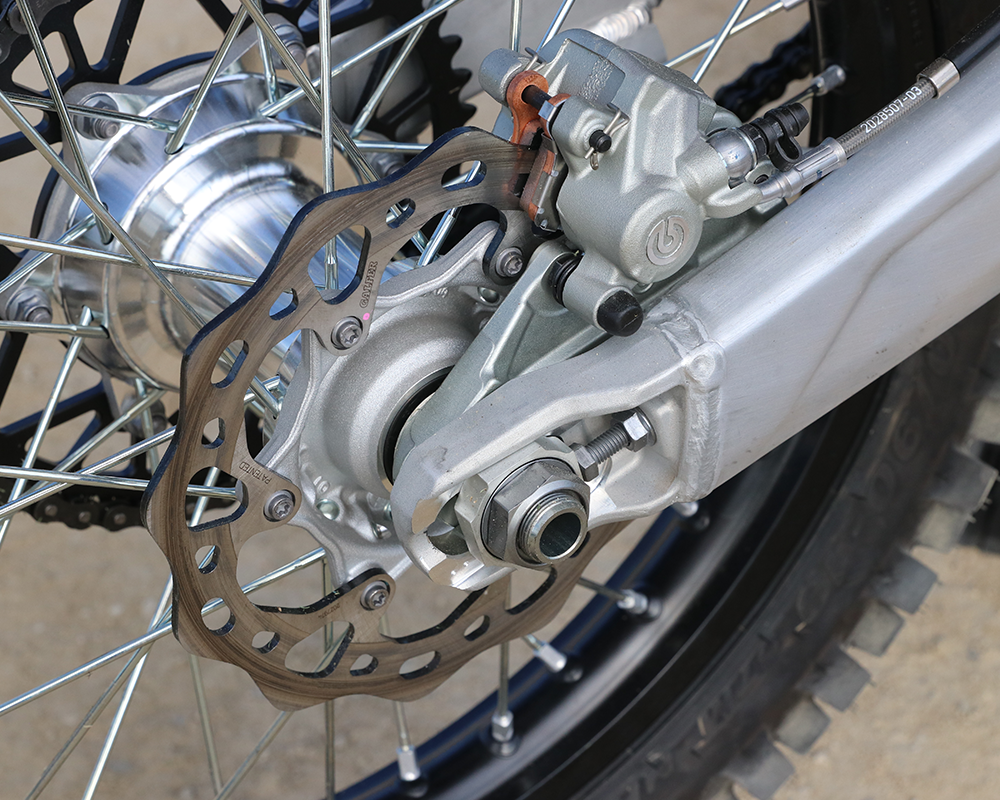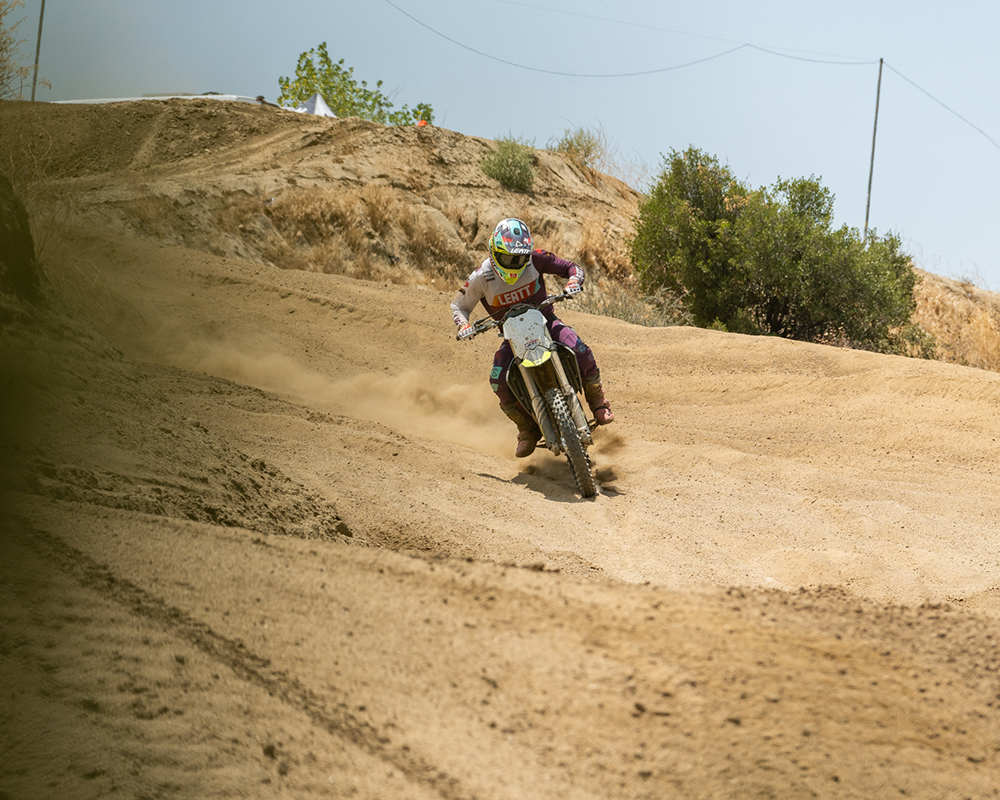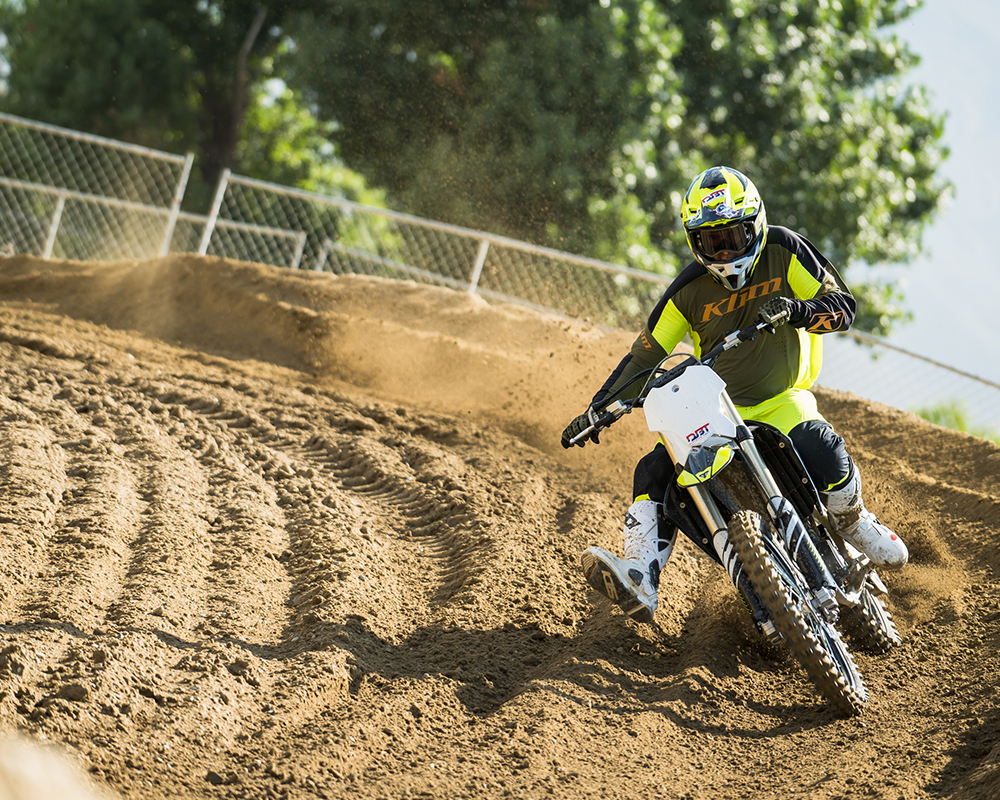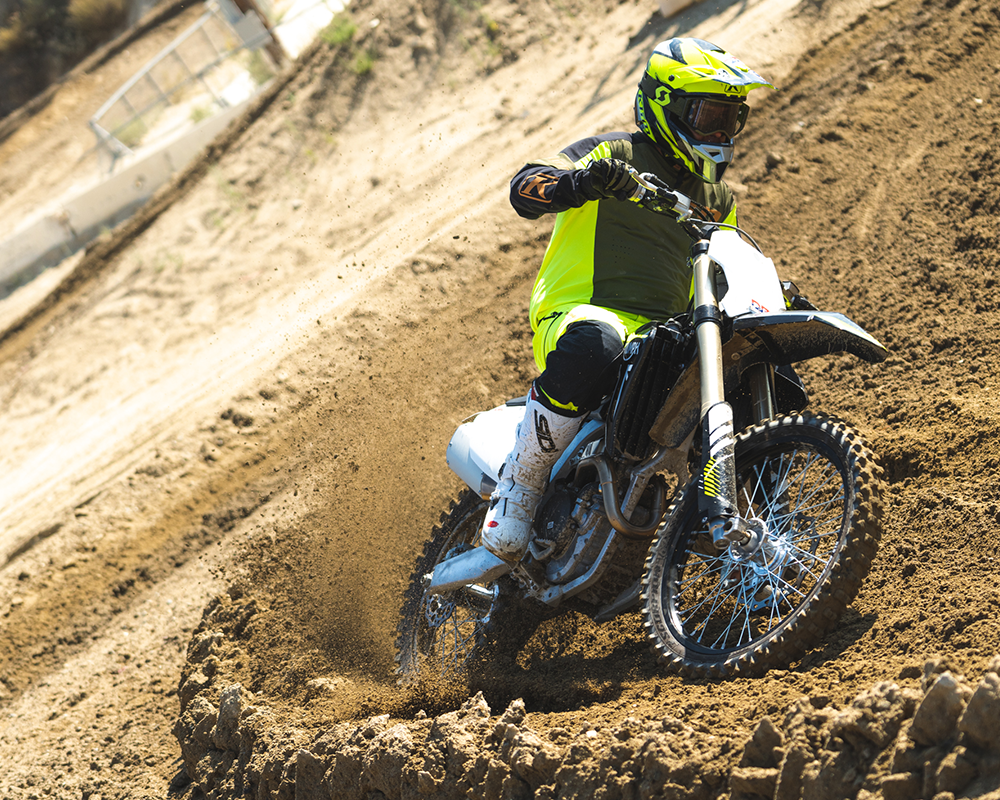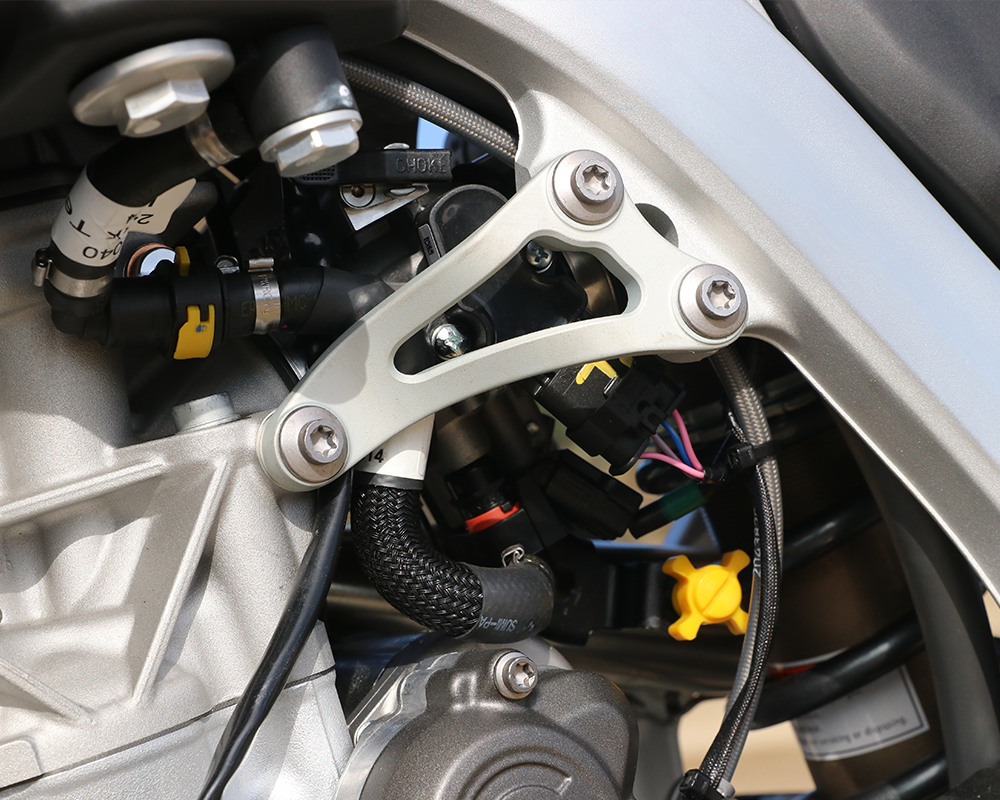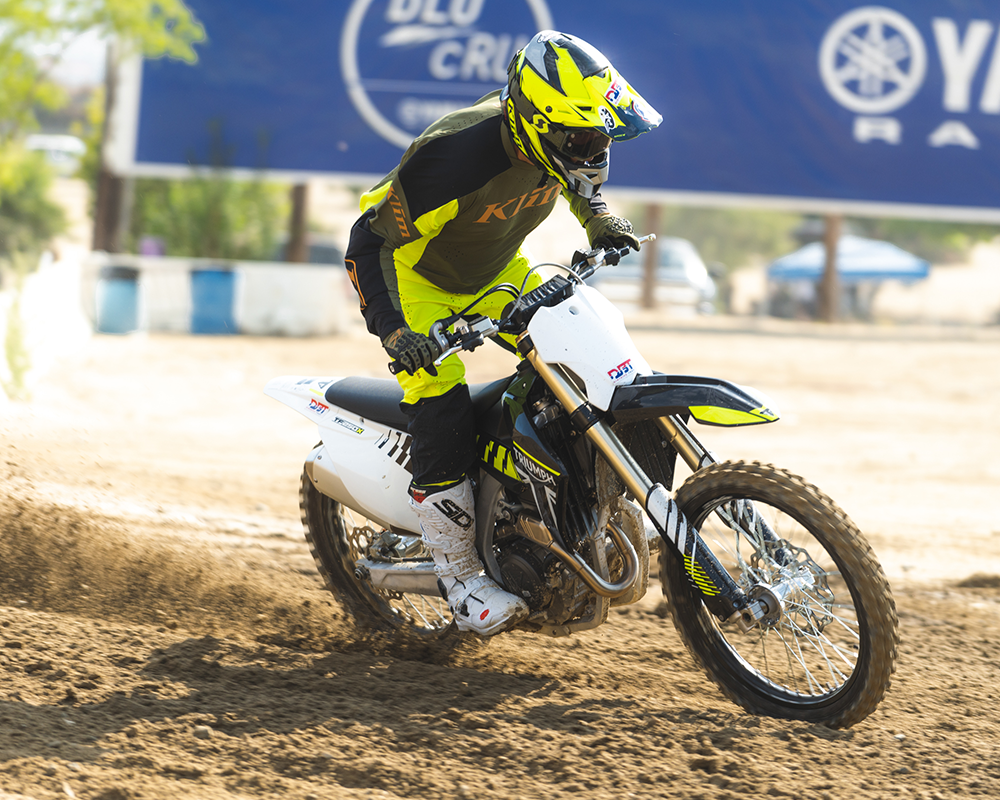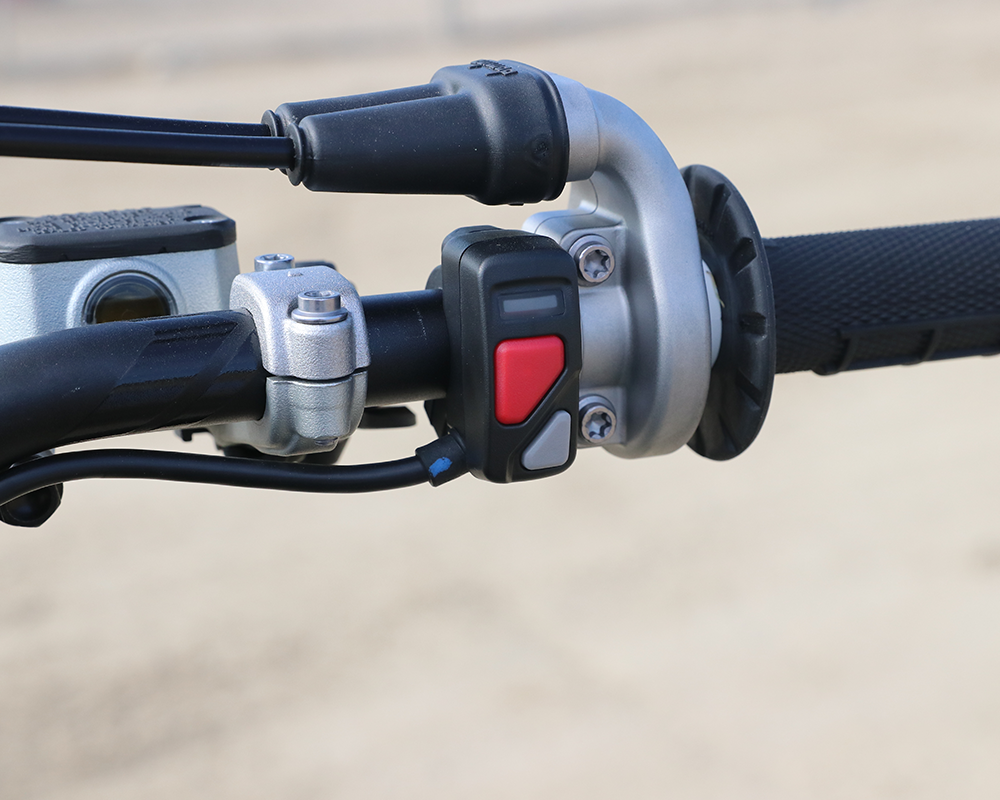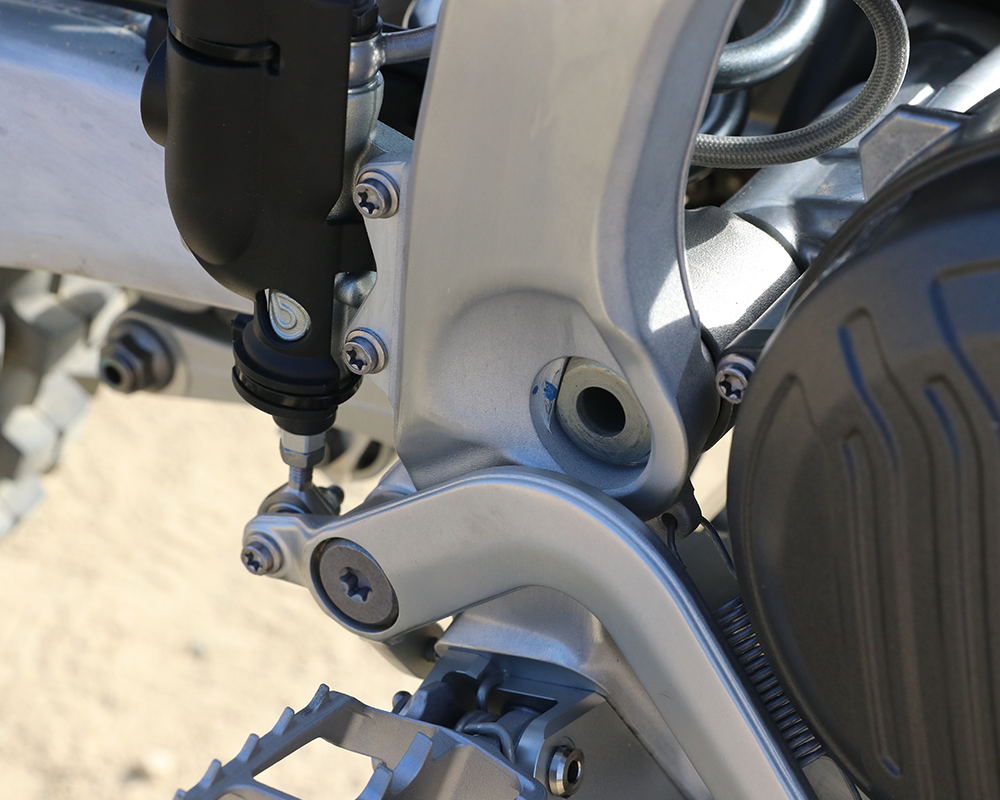2024 Triumph TF 250-X
Award Winning Rookie Year
MSRP: $9995
- Really fun to ride, easy to feel comfortable on very quickly.
- Fresh new brand to the class.
- Awesome handling chassis.
- Quality components like: KYB, Brembo, Pro Taper, Excel, Twin-Air, and Athena
- Torx hardware takes a little getting used to, why didn’t they use hardware like KTM with 8 mm and 10 mm hex heads?
- 12mm and 13mm nuts.
- Power delivery has small dips in the power curve.
Introduction
- Triumph's first crack at a production 250F motocross model.
Redesigned or updated models are always a welcomed entity, yet when a brand like Triumph, whom has a lineage going back to 1902, announces they plan to build their first 250F motocross bike, heads started to explode. “Are they serious or will they rebrand a bike from China?” When Triumph announced their plan with the likes of Ricky Carmichael, Dave Arnold, and test rider Ivan Tedesco working on the project, we knew they were as serious as a heart attack. Nobody knew what to expect and why they were going after the 250F market first, yet it all worked out in the end. First looks had some saying it resembled a 2009 YZ250F frame with a KTM engine. We came to discover none of that was true. Yes, the look might have some vague similarities, but after riding and working on the bike, it’s all Triumph.
For Triumph, they didn’t go the Cannondale route and attempt to reinvent the wheel. They painted within the lines of what most expect from a moto bike when the canvas was dry, they presented a really solid product that handles well, feels comfortable after one lap, and is really fun to ride. Note that after a few hours we updated the tires with Dunlop MX34s and went up to a 110 over the standard 100 series. We also swapped out the stock 48-tooth rear sprocket for a Pro X 49-tooth. We also had to lengthen the chain two links.
Changes
- All new, first year model for Triumph.
Let us go over and itemize the list of changes for the 2024 TF 250-X. EVERYTHING! This is the first production modern-era 250cc motocross bike from Triumph. We applaud the fact that Triumph utilized quality components to help build their new line and names that have a solid reputation in the industry—KYB suspension, Brembo brakes, DID, ProTaper, Twin Air, ODI, and Athena to name a few of the top players. Other features include a 5-speed transmission, Dellorto throttle body, and Belleville style single-spring clutch. It sports an hour meter, and they claim the frames are all hand-welded for precision. Wet weight with no fuel according to the specs is 16.36 stones or as us Yankees call it, 229 pounds. Price tag is right there at a suggested $9,995.00. Triumph actually has six different manufacturing facilities, the 250-X is tagged as being made in Thailand. Don’t let the region cause you any concern, you would be surprised how many parts are made all over the world, even if the brand says made in Austria or Japan.
Power
- Strong motor that's easy to ride.
- Makes great power in the upper mid range to lower top end.
The performance of the Triumph 250-X can be subjective. No, it might not be the fastest-feeling bike or have peak mid-range grunt of the Yamaha YZ250F, but it works. This engine isn't the most linear, but rather has surges and small dips throughout the powerband. It starts off good down low, has a small dip as you transition into the mid range, kicks back into the meat of the power in the upper mid range and through the lower top end before signing off earlier than a traditional 250F. Experienced riders were able to keep the bike right in the sweet spot in that upper mid/lower top end range, but you have to nail the shift points and shift off of feel and not sound of the bike.
It doesn't have the top end of a KTM or the previous gen Kawasaki, and it doesn't quite have the low end of a Yamaha, but it takes a blend of all of those bikes and puts it together in one package, a common trait on the rest of the bike. If you like the sound of a rev limiter, this isn't the engine for you. But if you like any power below the rev limiter, this engine has it and puts it to the ground.
Engine tuners have tried to get into the ECU but so far have not been able to make fine adjustments. The Athena ECU does have 10 different maps to pick from, but you have to have the tuner to change them. However, you are not able to add or subtract fuel or retard or advance the ignition like you can in Yamaha or Kawasaki's tuning apps. We have heard the 2025 has updated ECU settings.
Despite the above, the Triumph is a very easy engine to ride with and if you have any experience riding a 125, you will really like riding the 250-X. The engine is fun and even our 195-pound rider felt he could ride a jump-filled track like Perris Raceway with no problem, clearing all of the jumps they normally hit on a 450.
Clutch action is very much on point and we never experienced any fade or strange traits. It slips really well and gets the engine back into the power with just a little finger action. The engagement and feel of the single-spring setup is for sure not a weak point during our time with the bike. The transmission is a five-speed, yet we rarely had to use the top cog. Shifting is solid, only hitting neutral a few times due to pilot error. Early on, we felt the shifting was notchy compared to most bikes these days, but it has gotten better over time and is nothing to complain about. Some of our riders really liked the Quick Shift feature and feel it's the best on the market at the moment. You kind of have to pick a shifting style—standard with the clutch or no clutch with the Quick Shift engaged on the handlebar. It takes a little time to get used to it but the feature is pretty cool. But be aware, if you have any pressure on the shifter, it can upshift pretty easy and is unexpected until you spend some time with the system. As for gearing, we wanted to tighten up the spread and have the ability to use more of third gear and not have to shift as much mid-corner. We went full MXA and went up one tooth on the rear sprocket. It does help. Yet note the chain is almost too short to add a tooth so we went with a longer chain and moved the rear back to make the change. This also affects the handling by moving the wheel back, but we feel in a good way.
Pros and really fast intermediates might want a meatier overrev and harder hit but for the average rider, the Triumph offers a really fun and easy performance platform and truly gives you that feeling of riding full-tilt. By no means is it slow, it’s just smooth, torquey, and fun to ride. We are unsure of the engine's longevity since it’s a brand-new platform. We logged nearly 20 hours on this bike thus far with no issues except standard oil changes and air filter service.
Suspension
- Softer, comfortable suspension package.
- Sensitive to ride height and balance.
- Quality KYB components.
Triumph did not pull any punches when choosing suspension. The KYB spring fork and shock do this chassis well. The action is good and valving is in the ballpark for a variety of riders. It’s hard to fault the KYB fork, they just work. The balance of the fork and shock are a tiny bit off, meaning the fork is slightly stiffer than the shock, yet with clickers and ride height, we were able to get things balanced out. The chassis likes right around 100-102mm of race sag. Some lighter riders had to soften the fork to match the shock and the heavier riders had to stiffen the shock.
In stock trim, the fork is on the soft side and provides a little bit of an unbalanced chassis. Fast and aggressive riders felt the fork would dive and get nervous feeling under a heavy load, and heavier (190+ lbs) riders felt it riding too low in the stroke (which is to be expected a little bit when riding a 250F). Our heavier vet riders actually really liked how the bike handled when we didn't bleed the air out of the forks. The air helped "stiffen" the fork as a band aid fix while using stock springs. Our faster riders stiffened up the fork compression 2-3 clicks and felt an improvement, but were still looking for a little more. On faster tracks, we dropped the fork height to 3mm to get some added stability and a stiffer action on decel under heavy loads.
The shock wasn't as sensitive and didn't require many changes in our time with the bike, though some of our riders felt going slightly stiffer on compression was needed. It’s not easy to decipher what complements what. The chassis helps the suspension or the suspension aids chassis, all we know is they work together well. Yes, some riders will need to fine tune clickers for their style or speed but the valving is very good stock for a variety of rider weights and speeds.
Chassis - Handling
- Chassis comfort is a highlight on this bike.
- Ergonomics are neutral for riders of all sizes.
- Build quality of this bike is very high.
To be honest, we think the new Triumph 250 shines the brightest starting with the chassis and bleeds its way out to the engine and suspension. The number-one praise from test riders all started with the chassis and how comfortable it is from the first lap. The rider triangle is very adaptable for riders from 5’7” to 6’1” and nothing feels out of place. Peg height, bar position to seat height, and pitch are all very comfortable. Triumph certainly did their homework when designing this motorcycle. The bike feels light while on the track and did not have any bad habits or traits. It turns really well, tracks through ruts, and keeps the power to the ground exiting on rough, rutted turns. We are not saying it turns like it’s on rails either, the chassis just works, tracks, and does not emit traits such as too much under or over steer. At a few tracks, the front can feel a little busy entering fast rough corners but nothing crazy. Adjusting the fork height can help but you take away a little bit of mid-corner precision.
The chassis offers a good feel and feedback to the rider onboard. It's not jarring and painful, but simply letting you know it's there and where it's going. In this sense, it's very confidence inspiring as it offers enough feel to trust it without scaring you. A lot of the new bikes these days are going stiffer and stiffer, and while there are some advantages to that, we feel it isn't always the best direction for the average rider buying the bike. Triumph didn't go in that direction and it has some of the positive cornering characteristics and feel that a stiff chassis might have, but without the negative points that come as a result.
The stock Pirelli tires are very good and we believe do help a little in the front end feel of the bike. They have a softer carcass feel and provide a lot of comfort and traction on all of the SoCal motocross tracks around here. We later installed Dunlop MX34's and our testers who rode the bike didn't feel much impact, showing the chassis is good with all tires.
Brembo brakes are tough to beat and it's no different on the Triumph. They offer good feel and power, don't fade, and are of high quality. Small things like the footpegs and controls all have a very nice feel to them. Some new or boutique bikes try to be unique in this area and it just doesn't work, but Triumph did it right.
The overall build quality of the bike is very high. Looking at it is like a work of art. Invest in a good set or Torx when you pick up this bike as nearly every bolt on this bike takes a Torx, but everything is where it should be, nothing is difficult to work on, and the routing and layout of the bike looks like a rider and mechanic had input on the design, not just a desk jockey designer who has never touched a wrench in his life.
Durability has seen zero faults up to this point with ~20 hours on the bike. The only thing we've replaced or touched are air filters, oil, and tires. The stock plastic still looks good, seat cover is holding up with no tears, the chain guide and slider all have life left in them. The biggest thing that looks "worn" in the rear rim as the tire scrub has worn some of the black off all the way around (a common thing with the softer Pirelli tires).
Conclusion
- Feels like a complete package that is refined and wise beyond its years.
- Very good starting point for a first year model.
For a first year model, it’s hard to find fault with Triumph and their efforts. No it’s not the fastest 250F we have ever ridden, but it's also not the slowes. It may not be a holeshot master, but it’s one of the most fun, confidence inspiring bikes for several of our test riders, and has proven to be an advantage during longer motos. The chassis is where the Triumph really shines. The suspension and chassis just work very well together. A few test riders noted the engine delivery may help contribute to the comfort, others said it worked because you could just keep it pinned like a typical 250F. If there's a rider in mind when asked who to recommend this bike to, a vet rider immediately pops up. The smooth power delivery and comfortable chassis bodes well with veteran riders who aren't looking to drag bar through corners and bounce off the rev limiter down every straightaway and off every jump.
After nearly 20 hours, the brakes are still powerful, wheels straight, clutch holding strong, engine is still singing, and chassis and suspension are still putting smiles on several of our test riders faces. Because it’s a brand-new manufacturer in the moto game, it’s hard to predict the 250-X’s long-term durability, yet we're here to show it and plan on digging deeper into this. We all know a 250F’s rebuild cycle is a lot shorter than a 450F, especially if you like banging the engine off the rev limiter or landing with full revs wide open. Triumph just announced their 450 and we are eager to toss a leg over it after having good feelings riding their 250F. Triumph has added some meat to the game with regard the 250F gang and the all-new TF 250-X is a contender.
Recent Product Tests
Leave a Reply
